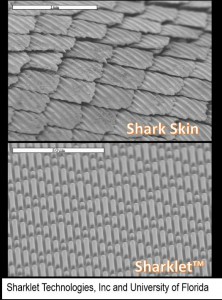 A guest blog from Dr. Ethan Mann, a research scientist at Sharklet Technologies, Inc, in which he discusses how different materials can prevent the spread of human disease bacteria.
A guest blog from Dr. Ethan Mann, a research scientist at Sharklet Technologies, Inc, in which he discusses how different materials can prevent the spread of human disease bacteria.
Microorganisms such as bacteria and viruses are contacted during interaction with everyday surfaces. Picking up germs from surfaces contributes to transmission of infectious diseases. Bacteria are able to survive on hard surfaces for days to weeks before they are reintroduced to a host. Once in a host, the bacteria are able to cause an illness often resulting in further propagation of the microorganism and potentially the need for treatment.
High touch public surfaces such as door handles and railings would benefit from a self-cleaning surface technology to reduce the amount of microorganisms between cleanings. Sharklet Technologies, Inc, located in Aurora, CO (Sharklet.com) has developed an imperceptible micropatterned surface able to reduce microorganism contamination due to its enhanced surface energy.
The Sharklet™ micropattern is a microtopography with ordered microscopic features either recessed or protruding from molded or embossed plastic surfaces. The Sharklet™ micropattern is a bioinspired technology modeled after shark skin surface texture.
Dr. Anthony Brennan at the University of Florida identified that enhancing surface energy through manipulating surface roughness results in the ability to control adhesion of biological organisms. Dr. Brennan clearly observed support of this hypothesis in nature on shark skin that remained free of fouling commonly seen on ships hulls or humpback whales. A closer examination of shark skin revealed that it possessed a predictable ordered surface roughness capable of limiting microorganism adherence.
The Sharklet™ micropattern has since been optimized to resist adherence by numerous bacteria and yeast species commonly found on every day surfaces. The broad efficacy of the Sharklet™ micropattern is a tremendous benefit to reducing the spread of diverse microorganisms.
The Sharklet™ micropattern requires no toxic chemicals or additives to reduce microorganism interaction. Often antimicrobials or toxic chemicals, present in alternative self-cleaning technologies, are developed to reduce a specific subset of microorganisms leaving an available niche for alternative microorganisms to exist due to minimized natural competition. Occasionally the secondary microorganisms, resistant to the antimicrobial or chemical, can cause a more devastating illness than the original microorganisms.
Microorganisms are often beneficial in our world. The Sharklet™ micropattern strives to reduce infectious microorganisms on surfaces were humans commonly interact but not to kill nonpathogenic microorganisms were they may be beneficial.
The Sharklet™ micropattern achieves minimal environmental impact because it can be produced in the identical plastics currently used on high touch surfaces. Minimal impact of the Sharklet™ micropattern is not only important for beneficial bacteria, but also for individuals like young children or elderly adults who may be sensitive to repeated exposure to harsh chemicals.
Sharklet Technologies, Inc is constantly evaluating novel applications for its Sharklet™ micropattern technology. Future wide implementation of the Sharklet™ micropattern will ultimately result in a cleaner world and presumably fewer illnesses.
[…] A guest blog from Dr. Ethan Mann, a research scientist at Sharklet Technologies, Inc, in which he discusses how different materials can prevent the spread of human disease bacteria. Microorganisms such as bacteria and viruses are contacted during interaction with everyday surfaces. Picking up germs from surfaces contributes to transmission of infectious diseases. Bacteria are able to survive on hard surfaces for days to weeks before they are reintroduced to a host. Once in a host, the bacteria are able to cause an illness often resulting in further propagation of the microorganism and potentially the need for treatment. High touch public surfaces such as door handles and railings would benefit from a self-cleaning surface technology to reduce the amount of microorganisms …Read more […]